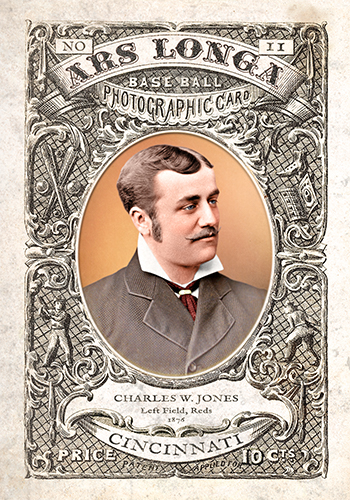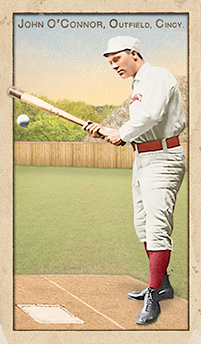
- Series: Beginnings: 1880's
- City: Cincinnati
- Team: Red Stockings (AA)
- League: American Association
John Joseph O’Connor (1866-1937) was as durable as they come. He holds the distinction, with a mere 28 others, of playing in four different decades in the majors. His durability was a product of his toughness. Despite the benign-sounding nickname of “Peach Pie,” O’Connor was known as one of the dirtiest players of his day and hard as nails. He excelled behind the plate, a position that devoured its occupants. With the Cleveland Spiders from 1892-98, O’Connor (also known as “Rowdy Jack”) hit .290+ four straight seasons. In his 21-year big league career, Jack hit a fine .263 He had started out with Cincinnati’s Red Stockings in 1887 and stayed in the Buckeye State with the Columbus Solons and Cleveland until he moved to St. Louis following the ‘98 campaign. He would move on to Pittsburgh and New York before landing back in St. Louis in 1904 where he remained through 1910.
Jack's waning days in St. Louis proved fateful for he and two of the game's all-time great hitters. Nap Lajoie and Ty Cobb were locked in a memorable duel for the batting title (and thus, the 1910 Chalmers Award) as the season wound down. O’Connor was the player/manager of the Browns when Lajoie’s Naps came to town for a season-ending double-header at Sportsman’s Park. History doesn’t record why O’Connor so strongly preferred Nap to win the title, but we might suppose Cobb wasn’t any more beloved in St. Louis than elsewhere. In any event, “Peach Pie” ordered his rookie third baseman Red Corriden to play back . . . way back, as in short left field. Lajoie proceeded to drop five bunts down the line, all for base hits. Lajoie reached base on his 6th at bat on a fielder's error, but O'Connor tried to bribe the official scorer to change the error to a hit, even offering to buy the woman a new wardrobe. The batting title and Chalmers Award went to Cobb despite the host’s accommodation. The difference in final average was minute, and the controversy inspired Chalmers to give both Lajoie and Cobb new cars. But the escapade cost O’Connor his job as league president Ban Johnson ordered him and Browns' owner Robert Hedges fired and banned. Decades later, research found Cobb had been double-credited with one day’s results. In 1981 Lajoie was declared the true winner of the batting title for 1910, by seven thousandths of a point. Rowdy Jack’s revenge….
- O'Connor's stunt got him blacklisted and unofficially banned from major league baseball for life
- At age 46, Jack returned to Cleveland’s Forest City club in 1912 for a last hurrah. No data survives for that team’s year but Baseball Reference records O’Connor managed the squad
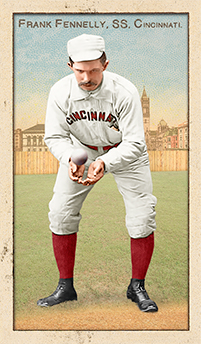
- Series: Beginnings: 1880's
- City: Cincinnati
- Team: Red Stockings (AA)
- League: American Association
Francis John Fennelly (1860-1920) came out of Fall River, MA to whack 34 career home-runs in the American Association. Not a bad sum for the era of flabby, misshapen baseballs. And, thanks to careful research, Frank’s effectiveness swinging a stout wooden implement does, indeed, exceed the prowess of his classmate and more famous hometown slugger, Lizzie Borden. Despite the scurrilous playground rhyme to the contrary, Lizzie used only about 30 blows to become the most famous self-made orphan in New England. Frank’s more prosaic career took him to Washington as a rookie with the Nationals in 1884 where he led the team in batting as their shortstop. He finished his debut year with Cincinnati where he hit .352 and earned his keep until traded to the Athletics during the ‘88 season. A brief stint with the Brooklyn Gladiators in 1890 concluded his major league experience. Overall, Fennelly’s BA was .257 with 175 stolen bases. He led the American Association in RBI (89) in 1885.
- The notorious axe murders occurred in 1892; two years after Frank returned home
- Frank was born six months before Lizzie, who outlived him by seven years
- Frank is buried in St. Patrick’s Cemetery; Lizzie is buried in Oak Grove Cemetery, next to her parents
- Series: Mort's Reserve
- City: Cincinnati
- Team: Reds (NL)
- League: National League
Charles Wesley Jones (1852-1911) was a star slugger in the NL and AA from 1875-88. Though he never led his teams to pennants, Jones held many early HR records, notably with Boston and Cincinnati. A victim of the Blacklist, Jones lost two seasons in his prime. Despite this, he was the career HR leader thru 1884.
- Was the first player to hit 2 HRs in same inning, 6/10/80. The pitcher was Tom Poorman
- Nickname: Baby
- Birth name: Benjamin Wesley Rippay
- Was the 274th player to debut in MLB
- Was an MLB umpire, 1890-1891
- According to Jay Jaffe's JAWS system, Charley ranks as the 80th best left fielder in MLB history, between Larry Hisle & Joe Rudi
- Until 2012 Jones was the best-known MLB player for whom death info was unknown. The “mystery” was solved by SABR researcher Greg Perkins.
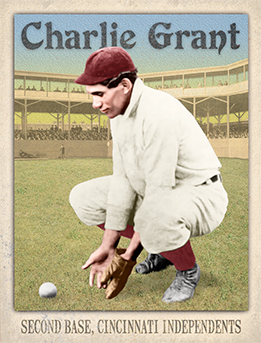
- Series: Diamond Heads '15
- City: Cincinnati
- Team: Stars (IND)
- League: Independent
Charles Grant Jr. (1874-1932) replaced Sol White at second base in 1896 when White left the Page Fence Giants, a move that came back to bite White's Cuban X-Giants later that year when Grant's team won the championship series 10 games to 5. Page Fence folded in '99 and Charlie moved to the Columbia Giants of Chicago. But is wasn't his prowess afield in the early Black leagues that brought Grant to the razor's edge of history. The smooth-fielding youngster worked in a hotel in Hot Springs, AR in the off-seasons where John McGraw's Orioles trained. McGraw, ever-voracious for talent, spied Grant playing pick-up games with co-workers and immediately judged him to be of major league caliber. The color-line was obdurate but McGraw seized on the ploy of passing Grant off as a Native American, even dubbing him “Tokohama” after a name he saw on the hotel's map. The scheme almost worked. Sol White tells the story of how McGraw's efforts to surreptitiously integrate the American League foundered when Baltimore went up to Chicago en route from spring training. Comiskey noticed that Grant's friends in town had shown up to applaud him and even sent a bouquet. Outed, McGraw had to yield to the league's segregation. White shared McGraw's esteem for Grant's ability: “I will give any 'fan' a good ten-cent cigar who will call my attention or, rather, recall my memory to an error on a ground ball or a muffed fly by Charley Grant.” His chance at national fame thwarted, Grant continued a very successful career in Black ball.
- Never a strong hitter, Grant always earned his keep at second. He died tragically, struck by a car that had blown a tire. In death, this great player received a measure of the recognition of which he was deprived by baseball's moguls. He is buried a short distance from Hall of Fame second-sacker Miller Huggins at Spring Grove Cemetery in Cincinnati
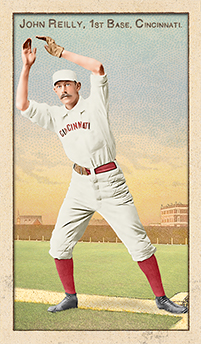
- Series: Beginnings: 1880's
- City: Cincinnati
- Team: Red Stockings (AA)
- League: American Association
John Good Reilly (1858-1937) was a one-man Big Red Machine long before the days of Bench, Morgan and Rose. When he was replaced at first base by Charles Comiskey in 1892, Long John held the Cincinnati Reds franchise records for singles, doubles, triples, home runs, runs scored, RBI, and games played. His decade with the Reds had seen Reilly consistently rank in the league's top ten in most offensive categories. In addition, his lean 6’3” frame made him a welcome first base target for his teammates. To this day, after more than a century of powerhouses in the Queen City, Reilly remains one of only four in team history to twice lead the league in HRs. In 2012 he was inducted into the Cincinnati Reds Hall of Fame, which according to the team’s website is the oldest continually operating team Hall of Fame.
- Reilly had been orphaned at age three when his father died in the Battle of Fort Donelson while serving as captain of a Union ironclad gunboat
- Long John grew up in Cincinnati as a professional artist until lured by his love of baseball. He was loyal to his hometown, retiring rather than moving to another club
- 69 career home runs were impressive for the era


